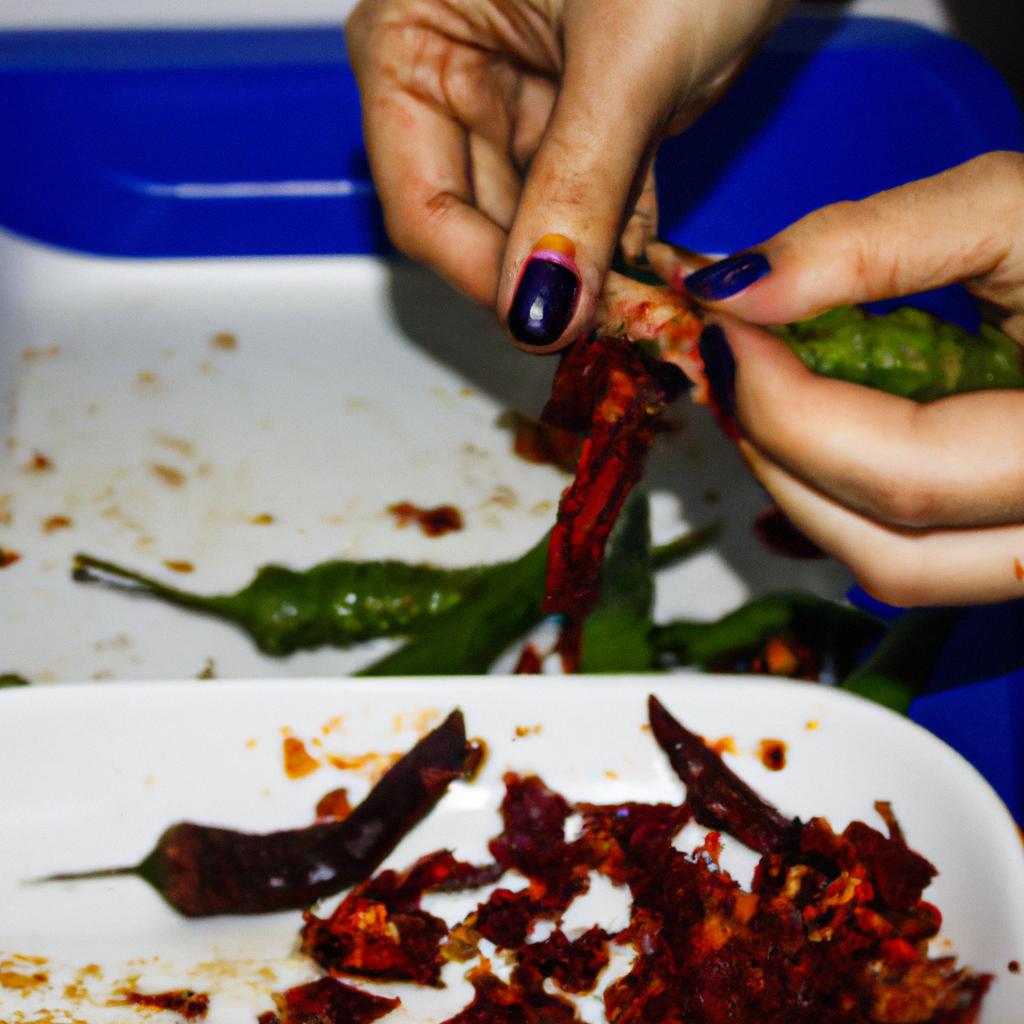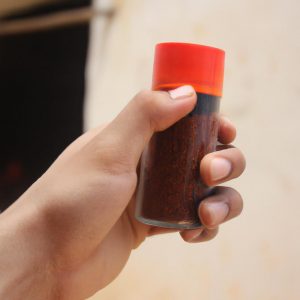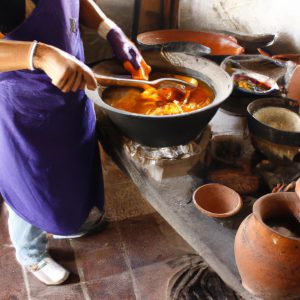The incorporation of fresh chilies in Mexican cuisine is a defining characteristic that distinguishes it from other culinary traditions. The heat provided by these vibrant peppers adds an intense and complex layer of flavor to various dishes, creating a sensory experience unlike any other. For instance, imagine biting into a perfectly grilled taco filled with succulent carne asada, topped with a generous dollop of freshly made salsa verde. As the flavors meld together on your tongue, you are instantly met with a burst of fiery heat that lingers and intensifies with each subsequent bite.
Chilies have been an integral part of Mexican food culture for centuries, dating back to the ancient civilizations such as the Aztecs and Mayans. These indigenous cultures not only recognized the unique taste profiles offered by different varieties of chili peppers but also discovered their medicinal properties. Capsaicin, the compound responsible for the spicy sensation produced by chilies, has been shown to possess anti-inflammatory and pain-relieving effects. Furthermore, studies suggest that capsaicin may even aid in weight loss and provide cardiovascular benefits. Thus, beyond its gustatory appeal, the inclusion of fresh chilies in Mexican cooking has both cultural significance and potential health benefits worth exploring further.
The Scoville Scale: Measuring Chili Heat
Imagine taking a bite of a seemingly harmless chili pepper, only to be overwhelmed by an intense burning sensation that lingers on your tongue. This experience is not uncommon when it comes to consuming chilies, as their heat levels can vary significantly from mild to scorching hot. To quantify and compare this heat, the Scoville scale was developed as a measurement system for chili peppers.
The Scoville scale, named after its creator Wilbur L. Scoville, measures the concentration of capsaicinoids in chili peppers – compounds responsible for the fiery sensation we associate with spiciness. Capsaicinoids bind to receptors on our taste buds and trigger a chemical response that results in the perception of heat. By diluting chili extracts until no heat is detected by a panel of tasters, the number of times the extract had to be diluted becomes its rating on the Scoville scale.
To better understand the diverse range of chili heats, here are some key points about the Scoville scale:
- The hottest chilies can reach over 2 million Scoville Heat Units (SHU), such as the Carolina Reaper.
- Mild chilies like bell peppers have zero SHUs since they lack capsaicinoids.
- Different varieties within a single type of chili may have varying heat levels due to factors such as growing conditions and genetics.
- The perceived intensity of spiciness can differ among individuals based on personal tolerance and sensitivity.
Table: Examples of Chili Peppers According to Their Position on the Scoville Scale
| Chili Pepper | SHU Range | Description |
|---|---|---|
| Bell Pepper | 0 | No noticeable spiciness |
| Poblano | 1,000 – 2,000 | Mild with subtle peppery flavor |
| Jalapeño | 2,500 – 8,000 | Moderately hot with a tangy taste |
| Habanero | 100,000 – 350,000 | Extremely hot with fruity undertones |
Understanding the Scoville scale allows us to navigate the world of chilies and make informed choices when it comes to incorporating them into our culinary adventures. In the following section, we will explore different types of fresh chilies commonly used in Mexican cuisine and delve deeper into their distinct flavors and levels of spiciness.
[Transition sentence: Now let’s move on to exploring the Different Types of Fresh Chilies Used in Mexican Cuisine.]
Different Types of Fresh Chilies Used in Mexican Cuisine
Fresh chilies are an integral part of Mexican cuisine, adding a fiery and distinctive flavor to various dishes. Understanding the different types of fresh chilies used in Mexican cooking is essential for appreciating the complexity and diversity of this vibrant culinary tradition. From mild and fruity peppers to intensely hot varieties, each chili brings its unique characteristics to the table.
Consider, for example, the popular jalapeño pepper. With its medium heat level, it adds a subtle kick to salsas, guacamole, and other traditional Mexican sauces. The jalapeño’s vivid green color and crisp texture make it visually appealing while complementing the flavors of many dishes. However, compared to other chilies on the Scoville scale, which measures chili heat intensity, jalapeños fall relatively low with a range of 2,500-8,000 Scoville Heat Units (SHU).
When exploring Mexican cuisine further, it becomes evident that there is more than just one type of chili pepper available. Here are some additional examples:
- Habanero: Known for its intense heat levels ranging from 100,000-350,000 SHU, habaneros deliver both tropical fruitiness and a fiery punch.
- Poblano: This versatile chili has a mild to medium heat profile (1,000-2,000 SHU) but offers rich earthy flavors ideal for stuffing or roasting.
- Serrano: With a similar heat range as jalapeños (10,000-25,000 SHU), serranos add brightness and depth to soups and stews.
To better understand these variations among fresh chilies commonly used in Mexican cuisine and their respective attributes like flavor profiles and recommended uses within recipes you can refer to the following table:
| Chili | Heat Level | Flavor Profile | Recommended Uses |
|---|---|---|---|
| Jalapeño | Mild-Medium | Fruity, Crisp | Salsas, Guacamole |
| Habanero | Very Hot | Tropical, Fruity | Spicy Sauces, Marinades |
| Poblano | Mild-Medium | Earthy, Smoky | Chiles Rellenos |
| Serrano | Medium-Hot | Bright, Herbaceous | Soups, Stews |
Understanding the diverse range of fresh chilies available in Mexican cuisine allows for a deeper appreciation of the intricacies within this culinary tradition. From mild to mouth-searingly hot varieties, each chili adds its unique characteristics and enhances the overall flavor profile of various dishes. In the subsequent section about “The Role of Fresh Chilies in Mexican Culinary Traditions,” we will explore how chilies have become an essential element deeply rooted in the cultural heritage and traditional practices of Mexican cooking.
The Role of Fresh Chilies in Mexican Culinary Traditions
From Different Types of Fresh Chilies to their Culinary Significance
Imagine yourself sitting in a traditional Mexican restaurant, overwhelmed by the vibrant colors and enticing aromas that surround you. As your server brings out a plate of sizzling fajitas, adorned with fresh chilies, your taste buds tingle with anticipation. In this section, we will explore the role of these fiery ingredients in Mexican culinary traditions.
Fresh chilies are not simply added to dishes for their heat; they bring a complex flavor profile that enhances the overall taste experience. Consider the case of molé sauce, a staple in Mexican cuisine. This rich and velvety sauce is made using various types of fresh chilies such as ancho, pasilla, and guajillo. Each chili adds its distinct depth of flavor, resulting in a harmonious blend that elevates any dish it accompanies.
To further comprehend the significance of fresh chilies in Mexican food culture, let us delve into some key points:
- Aromatic Power: Fresh chilies possess intense aromatic properties that infuse dishes with irresistible scents capable of stimulating our appetite.
- Flavor Enhancers: These peppers provide an extra layer of complexity to recipes through their unique combination of sweetness, smokiness, bitterness or fruitiness.
- Versatility: From salsas to soups and stews, fresh chilies find their way into countless Mexican dishes where they lend character and spice.
- Regional Variations: Mexico’s diverse geography has given rise to regional cuisines showcasing different types of fresh chilies used according to local preferences.
Now let us take a moment to appreciate the myriad varieties available through the following table:
| Chili Variety | Heat Level (Scoville Units) | Flavor Profile |
|---|---|---|
| Habanero | 100,000 – 350,000 | Fruity and Smoky |
| Jalapeño | 2,500 – 8,000 | Mild with Earthy Notes |
| Serrano | 10,000 – 23,000 | Crisp and Bright |
| Poblano | 1,000 – 2,500 | Rich and Subtle |
As you explore the diverse world of Mexican cuisine, it becomes evident that fresh chilies play a crucial role in both flavor and cultural heritage. Their aromatic power, unique flavors, versatility across dishes, and regional variations make them indispensable ingredients in this vibrant culinary tapestry.
Transitioning to our next section about “The Health Benefits of Consuming Fresh Chilies,” we will now uncover how these fiery peppers can provide more than just gustatory delight.
The Health Benefits of Consuming Fresh Chilies
Having explored the significant role of fresh chilies in Mexican culinary traditions, it is imperative to delve into another aspect that makes these fiery peppers truly remarkable—their potential health benefits. By understanding how consuming fresh chilies can positively impact our well-being, we gain a deeper appreciation for their presence in Mexican cuisine.
Health Benefits of Consuming Fresh Chilies
To illustrate the beneficial effects of incorporating fresh chilies into our diet, let us consider an example. Imagine Maria, a middle-aged woman with a family history of cardiovascular disease. Seeking natural ways to improve her heart health, she starts adding fresh chilies to her meals regularly. Over time, Maria notices positive changes such as lower blood pressure and improved cholesterol levels—a testament to the potential cardio-protective properties of these vibrant peppers.
In addition to their tantalizing taste and heat-inducing nature, fresh chilies offer numerous health advantages. Here are some key benefits worth noting:
- Rich source of vitamins and minerals
- Natural pain relief through capsaicin compound
- Enhanced metabolism and weight management
- Potential anti-inflammatory effects
This table summarizes the specific nutrients found in fresh chilies and their associated health benefits:
| Nutrient | Health Benefit |
|---|---|
| Vitamin C | Boosts immune system |
| Vitamin A | Supports eye health |
| Potassium | Regulates blood pressure |
| Capsaicin | Alleviates pain and aids digestion |
By referring to this table, one can appreciate the comprehensive range of advantages available through regular consumption of fresh chilies.
Understanding the potential health perks offered by fresh chilies opens up new possibilities for individuals seeking overall wellness improvements. Incorporating these spicy delights into various dishes not only adds flavor but also provides vital nutrients that contribute to maintaining good health. Moving forward, let us explore some practical tips for handling and cooking with fresh chilies, ensuring an enjoyable culinary experience while harnessing their full potential.
With a firm grasp on the health benefits of fresh chilies, we can now turn our attention to valuable insights about handling and cooking with these vibrant peppers.
Tips for Handling and Cooking with Fresh Chilies
In the previous section, we explored the numerous health benefits associated with consuming fresh chilies. Now, let us delve deeper into some practical tips for handling and cooking with these fiery peppers to fully harness their potential.
Imagine a scenario where you have just purchased a batch of vibrant red jalapeno peppers from your local market. You are eager to incorporate them into your favorite Mexican dishes but unsure how to handle them properly. Here are some essential tips that will help you make the most out of your fresh chilies:
-
Selecting the right chili: Choose peppers that are smooth, shiny, and firm. Avoid those with blemishes or soft spots as they may indicate spoilage.
-
Storing fresh chilies: To keep your chilies fresher for longer, store them in a paper bag or perforated plastic bag in the refrigerator’s vegetable drawer. This way, they can retain their crispness and flavor for up to two weeks.
-
Handling precautions: When handling fresh chilies, it is crucial to wear gloves or wash your hands thoroughly afterward. The capsaicin compound found in chilies can cause skin irritation and even painful sensations if it comes into contact with sensitive areas like eyes or open wounds.
-
Cooking techniques: There are various ways to utilize fresh chilies in your culinary endeavors. Consider incorporating them through methods such as roasting, grilling, sautéing, or blending into sauces and salsas.
To further illustrate the versatility of fresh chilies in Mexican cuisine, here is an emotional bullet-point list showcasing their transformative power:
- Adds a burst of vibrant color and flavor to dishes
- Infuses a delightful heat level that tantalizes taste buds
- Provides a natural source of vitamins A and C
- Releases endorphins that contribute to feelings of happiness and well-being
Additionally, allow us to present a table that highlights the Scoville heat units (SHU) of several common fresh chilies:
| Chili Pepper | Scoville Heat Units |
|---|---|
| Jalapeno | 2,500 – 8,000 |
| Serrano | 10,000 – 23,000 |
| Habanero | 100,000 – 350,000 |
| Ghost Pepper | Over 1 million |
By understanding and following these guidelines for handling and cooking with fresh chilies, you can elevate your culinary experiences while reaping their health benefits. Now that we have covered the essentials of incorporating fresh chilies into your dishes successfully let us move forward to explore popular Mexican recipes that proudly showcase the fiery essence of these peppers.
[Transition Sentence]
Exploring Popular Mexican Dishes that Highlight Fresh Chilies
From handling and cooking with fresh chilies, let’s now explore popular Mexican dishes that highlight the vibrant flavors of these spicy ingredients. One such dish is the traditional Mexican stew called “chile verde.” This hearty dish combines chunks of tender pork simmered in a flavorful green chili sauce made from roasted tomatillos and jalapenos. The richness of the meat complements the smoky and tangy notes of the chilies, creating a harmonious balance of flavors.
When it comes to Mexican cuisine, there are various ways to incorporate fresh chilies into dishes to enhance their taste profile. Here are some examples:
- Salsas: Fresh chilies can be used as key ingredients in salsas, adding heat and depth of flavor. Whether it’s a fiery habanero salsa or a milder pico de gallo with diced jalapenos, salsas offer a burst of spiciness that elevates any Mexican meal.
- Tacos: Chopped fresh chilies can be added to fillings for tacos, providing an extra kick of heat. From classic carne asada tacos with serrano peppers to vegetarian options like grilled vegetable tacos with poblano peppers, the range of possibilities when it comes to incorporating chilies into this beloved street food is endless.
- Soups and stews: Fresh chilies lend themselves well to soups and stews, infusing warmth and complexity. From robust tortilla soup featuring pasilla peppers to comforting pozole enriched by guajillo chilies, these dishes showcase how fresh chilies can transform simple broth-based recipes into culinary delights.
- Marinades: Fresh chilies make excellent additions to marinades for meats and vegetables. They not only add spice but also help tenderize proteins while imparting their unique flavors. A marinade consisting of chipotle peppers blended with garlic, lime juice, and other seasonings can take your grilled chicken or tofu skewers to the next level.
- Excitement: The mere mention of fresh chilies can ignite excitement among food enthusiasts who seek bold and vibrant flavors.
- Adventure: Trying dishes that feature fresh chilies introduces an element of culinary adventure, encouraging individuals to step out of their comfort zones and experience new taste sensations.
- Satisfaction: The satisfying heat provided by fresh chilies adds depth and complexity to Mexican dishes, leaving diners with a feeling of contentment after each flavorful bite.
- Authenticity: Fresh chilies are an essential component of authentic Mexican cuisine, allowing individuals to connect with the rich cultural heritage associated with these beloved ingredients.
Lastly, here is a table showcasing different types of fresh chilies commonly used in Mexican cooking:
| Chili Variety | Heat Level (Scoville Units) | Flavor Profile |
|---|---|---|
| Jalapeno | 2,500 – 8,000 | Mild heat, slightly tangy |
| Serrano | 10,000 – 23,000 | Medium heat, crisp flavor |
| Habanero | 100,000 – 350,000 | Intense heat with fruity undertones |
| Poblano | 1,000 – 2,000 | Mild heat with earthy notes |
In conclusion,
Fresh chilies play a vital role in creating the distinctive flavors found in Mexican cuisine. By exploring popular dishes like “chile verde” and incorporating fresh chilies into salsas, tacos fillings, soups and stews, and marinades, one can truly appreciate the multifaceted nature of these spicy ingredients. So go ahead and embrace the passion-inducing power of fresh chilies as you embark on your gastronomic journey through Mexican food.











More Stories
Mexican Oregano: The Essential Ingredient in Mexican Food
Cilantro: The Essential Ingredient in Authentic Mexican Cuisine
Epazote: Discovering the Essential Mexican Food Ingredient